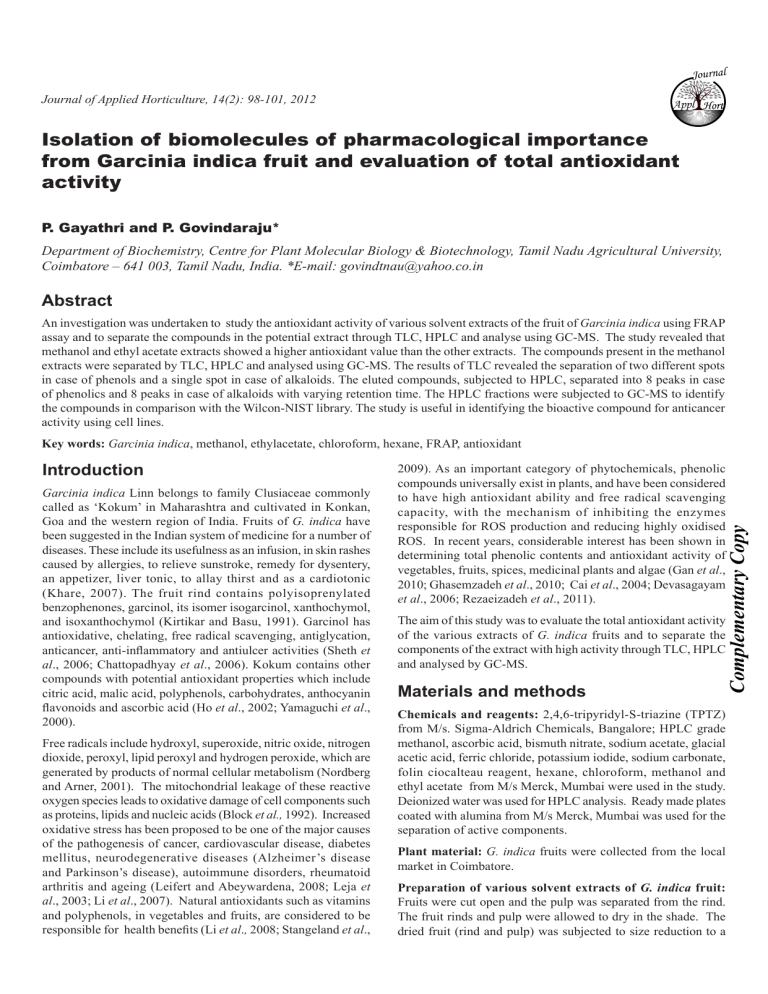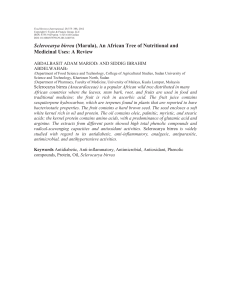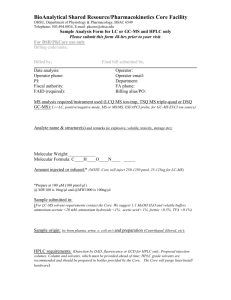
Journal Journal of Applied Horticulture, 14(2): 98-101, 2012 Appl Isolation of biomolecules of pharmacological importance from Garcinia indica fruit and evaluation of total antioxidant activity P. Gayathri and P. Govindaraju* Department of Biochemistry, Centre for Plant Molecular Biology & Biotechnology, Tamil Nadu Agricultural University, Coimbatore – 641 003, Tamil Nadu, India. *E-mail: govindtnau@yahoo.co.in Abstract An investigation was undertaken to study the antioxidant activity of various solvent extracts of the fruit of Garcinia indica using FRAP assay and to separate the compounds in the potential extract through TLC, HPLC and analyse using GC-MS. The study revealed that methanol and ethyl acetate extracts showed a higher antioxidant value than the other extracts. The compounds present in the methanol extracts were separated by TLC, HPLC and analysed using GC-MS. The results of TLC revealed the separation of two different spots in case of phenols and a single spot in case of alkaloids. The eluted compounds, subjected to HPLC, separated into 8 peaks in case of phenolics and 8 peaks in case of alkaloids with varying retention time. The HPLC fractions were subjected to GC-MS to identify the compounds in comparison with the Wilcon-NIST library. The study is useful in identifying the bioactive compound for anticancer activity using cell lines. Key words: Garcinia indica, methanol, ethylacetate, chloroform, hexane, FRAP, antioxidant Garcinia indica Linn belongs to family Clusiaceae commonly called as ‘Kokum’ in Maharashtra and cultivated in Konkan, Goa and the western region of India. Fruits of G. indica have been suggested in the Indian system of medicine for a number of diseases. These include its usefulness as an infusion, in skin rashes caused by allergies, to relieve sunstroke, remedy for dysentery, an appetizer, liver tonic, to allay thirst and as a cardiotonic (Khare, 2007). The fruit rind contains polyisoprenylated benzophenones, garcinol, its isomer isogarcinol, xanthochymol, and isoxanthochymol (Kirtikar and Basu, 1991). Garcinol has antioxidative, chelating, free radical scavenging, antiglycation, anticancer, anti-inflammatory and antiulcer activities (Sheth et al., 2006; Chattopadhyay et al., 2006). Kokum contains other compounds with potential antioxidant properties which include citric acid, malic acid, polyphenols, carbohydrates, anthocyanin flavonoids and ascorbic acid (Ho et al., 2002; Yamaguchi et al., 2000). Free radicals include hydroxyl, superoxide, nitric oxide, nitrogen dioxide, peroxyl, lipid peroxyl and hydrogen peroxide, which are generated by products of normal cellular metabolism (Nordberg and Arner, 2001). The mitochondrial leakage of these reactive oxygen species leads to oxidative damage of cell components such as proteins, lipids and nucleic acids (Block et al., 1992). Increased oxidative stress has been proposed to be one of the major causes of the pathogenesis of cancer, cardiovascular disease, diabetes mellitus, neurodegenerative diseases (Alzheimer’s disease and Parkinson’s disease), autoimmune disorders, rheumatoid arthritis and ageing (Leifert and Abeywardena, 2008; Leja et al., 2003; Li et al., 2007). Natural antioxidants such as vitamins and polyphenols, in vegetables and fruits, are considered to be responsible for health benefits (Li et al., 2008; Stangeland et al., 2009). As an important category of phytochemicals, phenolic compounds universally exist in plants, and have been considered to have high antioxidant ability and free radical scavenging capacity, with the mechanism of inhibiting the enzymes responsible for ROS production and reducing highly oxidised ROS. In recent years, considerable interest has been shown in determining total phenolic contents and antioxidant activity of vegetables, fruits, spices, medicinal plants and algae (Gan et al., 2010; Ghasemzadeh et al., 2010; Cai et al., 2004; Devasagayam et al., 2006; Rezaeizadeh et al., 2011). Complementary Copy Introduction The aim of this study was to evaluate the total antioxidant activity of the various extracts of G. indica fruits and to separate the components of the extract with high activity through TLC, HPLC and analysed by GC-MS. Materials and methods Chemicals and reagents: 2,4,6-tripyridyl-S-triazine (TPTZ) from M/s. Sigma-Aldrich Chemicals, Bangalore; HPLC grade methanol, ascorbic acid, bismuth nitrate, sodium acetate, glacial acetic acid, ferric chloride, potassium iodide, sodium carbonate, folin ciocalteau reagent, hexane, chloroform, methanol and ethyl acetate from M/s Merck, Mumbai were used in the study. Deionized water was used for HPLC analysis. Ready made plates coated with alumina from M/s Merck, Mumbai was used for the separation of active components. Plant material: G. indica fruits were collected from the local market in Coimbatore. Preparation of various solvent extracts of G. indica fruit: Fruits were cut open and the pulp was separated from the rind. The fruit rinds and pulp were allowed to dry in the shade. The dried fruit (rind and pulp) was subjected to size reduction to a Isolation of biomolecules of pharmacological importance from Garcinia indica fruit Total antioxidant activity: The total antioxidant activity of the extract of G. indica was assayed by FRAP method (Ferric Reduction Antioxidant Power) (Benzie and Strain, 1996). One hundred microlitre of the diluted sample was added to 3 mL of the FRAP reagent. The absorbance of the mixture was measured at 593 nm in 1cm light path at 37º C using ELICO SL159 UV–Vis spectrophotometer after 4 min. Briefly, the FRAP reagent was prepared from sodium acetate buffer (300 mM, pH 3.6), 10 mM TPTZ solution (40 mM HCl as solvent) and 20 mM iron (III) chloride solution in a volume ratio of 10:1:1, respectively. The FRAP reagent was prepared fresh every time and warmed to 37° C in a water bath before use. A standard solution of 1 mM ascorbic acid was tested in parallel and the results were expressed as mg ascorbic acid equivalents/g dry weight of fruit. Thin layer chromatography: TLC of various extracts of G. indica whole fruit was performed using readymade plates coated with alumina. In brief, the plates were cut to the required dimension (8 x 4 cm) and the extract was spotted using a capillary tube leaving a distance of 1 cm from the bottom, for 10-15 times to get a concentrated spot. The spotted plates were placed in a solvent system of Chloroform: acetic acid (9:1) in a closed chamber and allowed for the run till the solvent mixture reached three-fourth of the plate. The plate was air dried and sprayed using the spray reagent Folin’s Ciocalteau (1:1 dilution) reagent followed by 20% Sodium carbonate, air dried followed by subsequent drying using drier to identify the presence of phenols. The solvent system chloroform : methanol (9:1) was used for the run and the Dragendorff’s reagent was used for spray to identify the presence of alkaloids. Dragendorff’s reagent was prepared as under (Sarkozi et al., 2006): Dragendorffs reagent: Solution A - 1.7 g bismuth nitrate in 100 mL distilled water: acetic acid (8:2); Solution B - 40 g KI in 100 mL distilled water; Solution C- 20 mL glacial acetic acid + 70 mL distilled water; Solution D - Mix 5 mL of solution A, 5 mL of olution B and 90 ml of solution C just before use. High performance liquid chromatography (HPLC) analysis conditions: Methanolic G. indica extract fractions separated by TLC were filtered using a 0.45 μm nylon filter. 15 μL of the extract was separated on a Waters dual-pump high-performance liquid chromatograph (HPLC) using a Waters C-18 Symmetry column (Milford, MA) and Diode Array Detector. The method used HPLC grade methanol (mobile phase A) and HPLC grade water (mobile phase B) with the following linear gradient programme: 85% A, 0 min.; 75% A, 15 min.; 70% A, 20 min.; 45% A, 24 min.; 10% A, 28 min.; 0% A, 30 min.; and 85% A, 35-40 min. Analytes were detected at 280 nm and the mobile phase flow rate was 1 mL/min. GC-MS conditions: The HPLC fractions of phenolics and alkaloids of G. indica fruit extract were subjected to GC-MS on a Perkin-Elmer Clarus 500 of mass range between 50-450 m/z with a flow rate of 1 mL/min. The injection volume was 1 μL and the Library used was Willey & NIST. Results and discussion The results of the total antioxidant activity determined by the FRAP assay revealed that the methanol extracts of G. indica fruit had the highest antioxidant activity in terms of mg ascorbic acid equivalents compared to the other solvent extracts. This may be due to the efficient extraction of various active components of antioxidant property especially the phenolics in the methanol extract. Table 1. Total antioxidant activity of G. indica fruit S.No Extract (1g dried sample) Total antioxidant activity 1. Aqueous 1.32 ± 0.13 2. Chloroform 0.63 ± 0.08 3. Ethyl acetate 6.53 ± 0.62 4. Methanol 7.60 ± 0.51 5. Petroleum ether 0.79 ± 0.25 6. Hexane 2.87 ± 0.39 Values are mean ± SD of triplicates and expressed as equivalents of mg ascorbic acid Phenolic compounds have specific health effects even though they are nonnutritive compounds. Antioxidant properties of phenolic compounds play a vital role in the antioxidative defence mechanisms of biological systems (Wright et al., 2001). The antioxidative effect of phenolics is due to a direct free radical scavenging activity (Halliwell et al., 2000; Halliwell, 1996), reducing activity and an indirect effect arising from chelation of prooxidant metal ions. The chelation of metal ions generally requires ortho-dihydroxylation on the phenyl ring in phenolic acids and flavonoids or the presence of a 3- or 5-hydroxyl group in flavonoids (Shahidi, 2000; Shahidi, 2007). Natural antioxidants can protect the human body against free radicals, and have also been shown to retard the progress of a variety of chronic diseases (cancer, heart disease, diabetes, etc.), as well as ameliorating or retarding lipid rancidity in foods (Wettasinghe and Shahidi, 1999; Kinsella et al., 1993). Complementary Copy coarse powder. The coarsely powdered form of shade dried whole fruit was extracted using various solvents viz., hexane, chloroform, methanol, ethyl acetate using mechanical grinder. Then the extracts were centrifuged and the supernatant was collected and the solvent was evaporated at room temperature. The semisolid extract obtained was stored in an airtight container in refrigerator for further use. The solution of aqueous extract was prepared by using normal saline as solvent for experiment. The suspension of hexane, chloroform, methanol and ethyl acetate extract of G. indica fruit was prepared in distilled water. 99 Thin Layer Chromatography of methanol extract of G. indica whole fruit was performed using various solvent systems to identify the presence of secondary metabolites viz., phenols and alkaloids. The results revealed the presence of phenolic compounds and alkaloids which was confirmed by the blue and orange colour spots obtained after spraying with the spray reagent. HPLC analysis of TLC phenolics fraction of G. indica whole fruit revealed the separation of the TLC phenol fraction into 4 major peaks and 5 minor peaks (Fig. 1) with retention time as mentioned in the Table 2. HPLC analysis of TLC alkaloid fraction of G. indica revealed the separation of the TLC alkaloid fraction into 3 major peaks and 5 minor peaks (Fig. 2) with retention time as mentioned in the Table 3. The phenolic HPLC fraction of G. indica extract was subjected to GC-MS and the compounds identified in the fraction upon comparison with the library are shown in Table 4. The alkaloid HPLC fraction of G. indica extract was subjected to GC-MS and 100 Isolation of biomolecules of pharmacological importance from Garcinia indica fruit Table 2. HPLC peaks of TLC phenolics fraction with retention time Peak No 1 2 3 4 5 6 7 8 9 Retention time 2.635 3.147 5.005 5.621 6.208 7.125 9.248 18.400 20.970 Table 3. HPLC peaks of TLC alkaloid fraction with retention time Fig. 1. HPLC of TLC phenolics fraction- G. indica Peak No 1 2 3 4 5 6 7 8 Retention time 3.135 4.133 5.312 6.144 9.621 18.325 20.853 34.630 Fig. 2. HPLC of TLC alkaloid fraction- G. indica the compounds identified in the fraction upon comparison with the library are shown in Table 5. Based on the study, it is concluded that G. indica fruit is a potent source of antioxidants. The compounds identified through GCMS can be tested for antioxidant and anticancer activity using different cell-lines. Further identification of active principles present in the extract and structural elucidation can be done using LC-MS and NMR. Compound Trans, Trans-3,12-Dimethoxy-1,6,10dodecatriene Tridecane,2,2,4,10,12,12-Hexamethyl7(3,5,5-trimethylhexyl Tetradecanoic Acid, 10,13-Dimethyl,Methyl Ester Octadecane M.W Formula 224 C14H24O2 1,7-Dimethoxy-1,6-Heptadiene 394 C28H58 270 C17H34O2 254 C18H38 156 C9H16O2 Complementary Copy Table 4. GC-MS of G. indica extract - Phenolics -HPLC fraction Table 5. GC-MS of G. indica extract-Alkaloid-HPLC fraction Compound M.W Formula 6-Methyl-7-(Trimethylsilyl)-5-Hepten-1-ol 200 C11H24OSi 2R,3R,4R,5S,6R,8S,10S)-5-Acetoxy-10Benzyloxy-8-Benzyloxymethyl 498 C29H38O7 References Tetradecanoic Acid, 10,13-Dimethyl, Methyl ester 270 C17H34O2 Benzie, I.F.F. and J.J. Strain, 1996. The ferric reducing ability of plasma (FRAP) as a measure of “antioxidant power”: The FRAP assay. Analytical Biochemistry, 239: 70–76. Block, G., B. Patterson and A. Subar, 1992. Fruit, vegetables, and cancer prevention: A review of the epidemiological evidence. Nutrition and Cancer, 18: 1-29. Cai, Y.Z., Q. Luo, M. Sun and H. Corke, 2004. Antioxidant activity and phenolic compounds of 112 traditional Chinese medicinal plants associated with anticancer. Life Science, 74: 2157-2184. Chattopadhyay, S.K. and S. Kumar, 2006. Identification and quantification of two biologically active polyisoprenylated benzophenones xanthochymol and isoxanthochymol in Garcinia species using liquid chromatography-tandem mass spectrometry. Biomed Chrom., 844 (1): 67-83. Devasagayam, T.A., A. Mishra, M.A. Bapat and J.C. Tilak, 2006. Antioxidant activity of Garcinia indica (kokam) and its syrup. Curr. Sci., 91(1): 90-93. Gan, R.Y., L. Kuang, X.R. Xu, Y. Zhang, E.Q. Xia and F.L. Song, 2010. Screening of natural antioxidants from traditional Chinese medicinal plants associated with treatment of rheumatic disease. Molecules, 15: 5988-5997. 1,2-Dihydro-1,4-Diphenylphthalazine 284 C20H16N2 Octadecane 254 C18H38 Ghasemzadeh, A., H.Z.E. Jaafar and A. Rahmat, 2010. Antioxidant activities, total phenolics and flavonoids content in two varieties of Malaysia young ginger (Zingiber officinale Roscoe). Molecules, 15: 4324-433. Halliwell, B. 1996. Antioxidants in human health and disease. Annual Review Nutrition, 16: 33-50. Halliwell, B., M.V. Clement and L.H. Long, 2000. Hydrogen peroxide in the human body. FEBS Letters, 486: 10-13. Ho, C.T.S., C.H. Sang, M.H. Liao, Pan and R.T. Rosen, 2002; Chemical studies on antioxidant mechanism of garcinol: analysis of radical reaction products of garcinol with peroxyl radicals and their antitumor activities. Tetrahed., 58: 10095-10102. Khare, C.P. 2007. Indian Medicinal Plants. An Illustrated Dictionary. Springer, p.279. Kinsella, J.E., B. Frackel and J. Kanner, 1993. Possible mechanisms for the protective role of antioxidants in wine and plant foods. Food Technology, 47: 85-89. Isolation of biomolecules of pharmacological importance from Garcinia indica fruit Sarkozi, A., G. Janicsak, L. Kursinszki and A. Kery, 2006. Chromatographia Suppl., 63: S81. Shahidi, F. 2000. Antioxidants in food and food antioxidants. Nahrung., 44: 158-163. Shahidi, F. 2007. Nutraceuticals and functional foods in health promotion and disease risk reduction. IUFoST. Shanghai, China, 567-569. Sheth, A.K., S.V. Joshi and K.D. Mitalia, 2006. The Herbs of Ayurveda, 1st ed., Vol 2, Bhavnagar. p.526. Stangeland, T., S.F. Remberg and K.A. Lye, 2009. Total antioxidant activity in 35 Ugandan fruits and vegetables. Food Chemistry, 113: 85-91. Wettasinghe, M. and F. Shahidi, 1999. Antioxidant and free radical scavenging properties of ethanolic extracts of defatted borage (Borago borealis L.) seeds. Food Chemistry, 67: 399-414. Wright, J.S., E.R. Johnson and G.A. DiLabio, 2001. Predicting the activity of phenolic antioxidants: theoretical method, analysis of substituent effects, and application to major families of antioxidants.. Journal of the American Chemical Society, 123: 1173-1183. Yamaguchi, F., M. Saito, T. Ariga, Y. Yoshimura and H. Nakazawa, 2000. Antioxidative and anti-glycation activity of garcinol from Garcinia indica fruit rind. J. Agri. Food Chem., 48: 180-185. Received: November, 2011; Revised: June, 2012; Accepted: July, 2012 Complementary Copy Kirtikar, K.R. and B.D. Basu, 1991. Indian Medicinal Plants. Allahabad: The Indian Press, 2nd ed., Vol. 1, p. 262. Leifert, W.R. and M.Y. Abeywardena, 2008. Cardioprotective actions of grape polyphenols. Nutrition Research, 28: 729-737. Leja, M., A. Mareczek and J. Ben, 2003. Antioxidant properties of two apple cultivars during long-term storage. Food Chemistry, 80: 303-307. Li, H.B., K.W. Cheng, C.C. Wong, K.W. Fan, F. Chen and Y. Jiang, 2007. Evaluation of antioxidant capacity and total phenolic content of different fractions of selected microalgae. Food Chemistry, 102: 771-776. Li, H.B, C.C. Wong, K.W. Cheng and F. Chen, 2008. Antioxidant properties in vitro and total phenolic contents in methanol extracts from medicinal plants. LWT - Food Science and Technology, 41: 385-390. Nordberg, J. and E.S.J. Arner, 2001. Reactive oxygen specie, antioxidants and the mammalian thioredoxin system. Free Radical Biology and Medicine, 31: 287-1312. Rezaeizadeh, A., B.Z. Zuki, M. Abdollahi, Y.M. Goh, M.M. Noordin, M. Hamid and T.I. Azmi, 2011. Determination of antioxidant activity in methanolic and chloroformic extracts of Momordica charantia, Afr. J. Biotechnol., 10 (24): 4932-4940. 101



